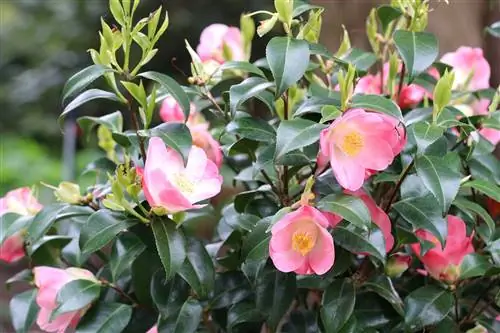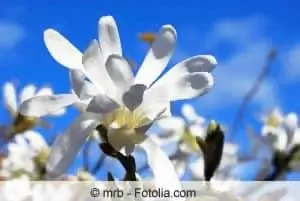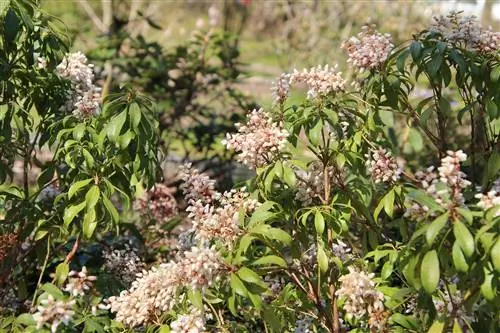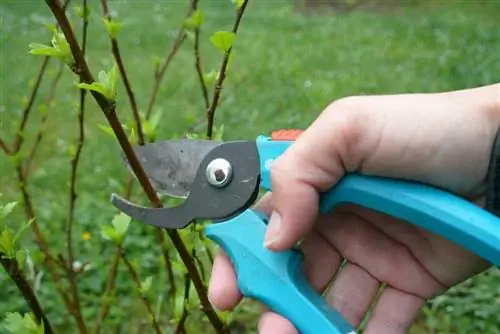- Author admin [email protected].
- Public 2023-12-17 03:39.
- Last modified 2025-06-01 06:48.
Flowering ornamental shrubs add liveliness to the garden and are ideal as design elements. Evergreen bushes can be used as a targeted eye-catcher or a groundbreaking element. Shrubs or bushes are, so to speak, the walls in the rooms of the garden. With their changing colors throughout the year, they create oases of relaxation.
Shrubs - a successful gift from nature
Shrubs are basically a synonym for the term bushes or bushes. These are perennial plants that are planted directly in the garden soil or in an appropriate pot. In contrast to perennials, shrubs become woody over time and therefore require regular pruning. However, they do not develop a trunk, but grow with woody shoots. Shrubs are therefore classified between trees and ground cover plants. This gives them basic characteristics that can be used wonderfully to design the garden. Let's see what options there are.
Link location and functionality
Before planting shrubs in the garden, it is important to choose the location carefully. If necessary, the shrub can be assigned a function: Can it expand in height and width to protect itself from view? On the other hand: With a talented gardener's hand, the Buxus can be cut into a ball shape, for example, and serves as an attractive design element in a garden with an English character or a Japanese-style oasis of peace. Alternatively, the flower color becomes a conscious component that gives the garden area its personal touch.
Tip:
Shrubs fulfill excellent functions such as privacy or provide shade.
Individual rooms create diversity and variety
Designing the garden is much easier if you divide individual areas into rooms. Each room has a specific theme and is planted with the appropriate plants. Individual shrubs and bushes then serve as an invisible partition and harmoniously demarcate the next area. In this way, gentle transitions are created, which can also include steps or paths. Lavender hedges, for example, are suitable for lots of color and captivating scents. In their delicate purple they welcome every visitor and exude their scent in the wind.
If you would like to protect yourself from unwanted looks from outside, you can decorate the entrance area of the garden with sprawling shrubs that grow tall and wide. For example, an evergreen cherry laurel is planted on a round arch instead of a rose. When cut creatively, the bushes can unfold in this way and prevent the view into the garden. A light, colorful plant such as the African ring basket goes well with the compact shrub, which loosens up the overall picture.
Magic - The hydrangea in the garden
Hytensias are popular plants in the garden with their voluminous, ball-like flowers. Strictly speaking, these are subshrubs and shrubs. They grow up to a height of two meters and are particularly effective on the house wall. Planted as a harmonious color complement or as a contrast, the hydrangea is an eye-catcher from a distance. The hydrangea grows up to 1.5 meters wide and looks very inviting when planted to the side of a resting area. As a visual frame, the classic garden bench becomes the favorite place for relaxing breaks. For example, a pink climbing rose with its delicate flowers in the background offers a magical contrast to the white hydrangea.
Tip:
Plant a small group of hydrangeas in a variety of colors or deliberately combine them with fragrant roses.
Location and care
Hydrangeas love a sunny to partially shaded place. The soil should be slightly moist, humus-rich and nutrient-rich. It is therefore advisable to fertilize the plants with a rhododendron fertilizer in spring and early summer. Hydrangeas in pots are better treated with a liquid fertilizer from March to around mid-August. If the leaves of the hydrangea turn yellow over the course of the year, they are lacking iron. The soil at this point lacks iron or it cannot be used by the plant. This can be remedied by watering with rainwater or an acidic fertilizer.
Taking advantage of the seasons
In summer all the beautiful flowers, fruits and bushes bloom. The garden stands in all its glory. But after summer the colors fade and the plants go into hibernation. In order to still enjoy the diversity of nature, bushes are selected according to their flowering time. Garden centers offer spring-blooming, summer-blooming, fall-blooming and winter-blooming shrubs. We present some of the winter and spring flowering shrubs here.
The camellia is one of the shrubs that bloom in winter. With its flower shape and color appearance, it conjures up a wonderful atmosphere in the garden. It can stay in the pot on the terrace down to -5 °C in the winter months. The cold is responsible for the flower buds opening. Protected from the wind and in a partially shaded spot, the camellia is an asset to any garden.
Other shrubs as winter bloomers are:
- Winter-blooming honeysuckle
- Winter Jasmine
- Parrotia or also called ironwood
- Snow Forsythia or Fragrant Viburnum
- Sal willow or pussy willow
In spring, these shrubs delight the garden owner:
- Germany
- Corkscrew Hazel
- Juliane's Barberry
- fingerbush
- Blueberry
The blueberry is also an excellent shrub in a naturally designed cottage garden. The dwarf shrub, up to 60 cm high, produces delicious fruits in summer and is a source of food for animals in winter. The caterpillars of various butterflies also use the blueberry as a feeding place. This also includes the willow cluck, which is threatened with extinction. The targeted planting of blueberries as a shrub also creates ecological benefits. Under good conditions, the shrub can live up to 30 years and reproduces through root creepers.
Frequently asked questions
Can all shrubs stay outside in winter?
No, especially plants that come from Mediterranean regions should be kept bright and cool in winter. At the latest when there is frost, the bushes are placed in the winter garden, a bright basement room or the greenhouse.
When are bushes cut?
Generally a good time is July or August or February to March before the branches emerge. Shrubs such as cherry laurel or boxwood are also trimmed throughout the year to keep them in the desired shape. Other shrubs don't need any pruning at all.
What distances from neighboring property must be maintained?
Shrubs up to a height of 2 meters must be planted at a minimum distance of 50 cm from the neighboring border.
Which shrubs are suitable for privacy protection in winter?
The fast-growing Leyland cypress (Cupressocyparis leylandii) or the columnar hornbeam is suitable for planting for permanent privacy. Please note that they need to be cut once or twice a year.
Other plants and shrubs for small gardens
- Ground cover plants: Ground cover plants are particularly suitable for use in a small garden. These don't get particularly high and can be easily confined to a relatively small space. Ground cover roses, for example, can add interesting touches of color to a small flower border without taking up unnecessary space.
- Climbing plants: Climbing roses or mallows are very suitable for small gardens. Provided with some climbing aids, these plants can be excellently grown up the walls of small gardens.
- Ferns: Ferns can be divided as desired in any year without suffering any damage.
- Bonsai: The bonsai, as a generally very small tree, fits very well into a small garden and can be a perfect focal point for garden design.
The new varieties include a lot of plants and shrubs for small gardens. The small trunks in particular, which can be planted in the ground or in a pot, are particularly suitable for small gardens. Many seed companies have interesting new varieties and even offer strawberries as stems, i.e. small trees. The many small types of fruit that do not grow on large trees but rather on narrow tendrils are also very suitable for use in small gardens. There are different types of fruit here, so you can plant apple and cherry trees even in a small garden.






